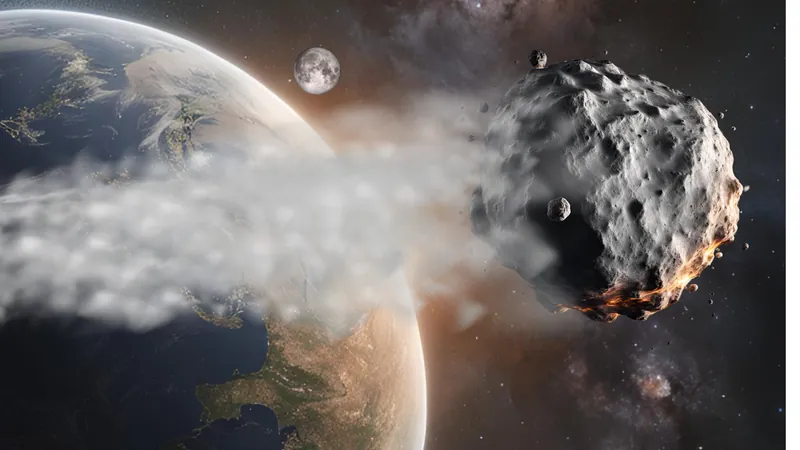
Earth's Mini-Moon Has Bid Farewell—Will It Return as Our Cosmic Companion?
2024-11-26
Author: Benjamin
Introduction
For the past few months, Earth has basked in the presence of a fascinating phenomenon: a “mini-moon.” This diminutive asteroid, formally known as 2024 PT5, joined our planet's orbit on September 29, 2024, but didn't hang around long enough to witness the Thanksgiving celebrations on November 28. On November 25, this cosmic visitor made its exit at precisely 10:43 a.m. EST (1543 GMT).
While it may seem sad to bid farewell to our small celestial companion, there's good news! The 37-foot-wide (11.2 meters) asteroid—equivalent to six stacked Arnold Schwarzeneggers—has the potential to return. The lingering question remains: Could 2024 PT5 enjoy another stint as Earth's mini-moon?
Insights from Carlos de la Fuente Marcos
Essential insights come from Carlos de la Fuente Marcos, a scientist at Universidad Complutense de Madrid. Marcos and his team have been meticulously studying mini-moon capture events, and they played a pivotal role in tracking the trajectory of 2024 PT5. They hypothesize that this asteroid originated from material dislodged from our moon during a collision.
Marcos provided some fascinating context about 2024 PT5. Usually residing in the Arjuna asteroid belt—a group of asteroids that orbit the sun near Earth—this asteroid typically hangs around 93 million miles (150 million kilometers) from our solar system's sun. Notably, objects in the Arjuna belt can become temporary residents of Earth if they approach within about 2.8 million miles (4.5 million kilometers) at slow velocities (approximately 2,200 miles per hour or 3,540 kilometers per hour).
To illustrate, Marcos likened a true satellite to a customer shopping inside a store, whereas mini-moons like 2024 PT5 are akin to window shoppers, peering in but never making a purchase.
The Return of a Cosmic Window Shopper
Using NASA’s Jet Propulsion Laboratory (JPL) database, astronomers can predict the future approaches of 2024 PT5. The next anticipated close encounter will be on January 9, 2025, when the asteroid will come within approximately 1.1 million miles (1.8 million kilometers) of Earth, traveling at around 2,300 miles per hour (3,700 kilometers per hour). Unfortunately, its speed may prevent it from being captured by Earth’s gravity during this visit.
Following this next approach, skywatchers will have to wait for the asteroid to circle back again on November 8, 2055. During this encounter, it will pass by more slowly at 1,498 miles per hour, but it will still be too distant, with an approach of 3.3 million miles, to become a mini-moon.
While it is virtually assured that 2024 PT5 will return in 2055, it’s crucial to point out that while theoretical capture is possible, the asteroid's trajectory may ultimately keep it moving safely past our planet.
Future Encounters
The signature close encounters don’t end there. In the following decades, another close approach is predicted on January 7, 2084, at an estimated 1 million miles away. This will be followed by an even nearer flyby on May 8, 2084, where predictions suggest a distance of around 2 million miles. The anticipation heightens as this may be the moment when 2024 PT5 once again becomes a temporary affiliated body of Earth.
The Rarity of Mini-Moons
For enthusiasts eager for the thrill of mini-moon captures, it’s worth noting that long-term mini-moon captures are quite rare—only two such occurrences are on record: 2006 RH120 and 2020 CD3, which orbited Earth for approximately one year each. However, short-term captures, like that of 2024 PT5, occur more frequently, with several events documented per decade.
So, while we wave goodbye to 2024 PT5 this time around, the cosmos might just surprise us again. The skies are full of possibilities, and who knows what other celestial wonders await us in our cosmic neighborhood!



 Brasil (PT)
Brasil (PT)
 Canada (EN)
Canada (EN)
 Chile (ES)
Chile (ES)
 Česko (CS)
Česko (CS)
 대한민국 (KO)
대한민국 (KO)
 España (ES)
España (ES)
 France (FR)
France (FR)
 Hong Kong (EN)
Hong Kong (EN)
 Italia (IT)
Italia (IT)
 日本 (JA)
日本 (JA)
 Magyarország (HU)
Magyarország (HU)
 Norge (NO)
Norge (NO)
 Polska (PL)
Polska (PL)
 Schweiz (DE)
Schweiz (DE)
 Singapore (EN)
Singapore (EN)
 Sverige (SV)
Sverige (SV)
 Suomi (FI)
Suomi (FI)
 Türkiye (TR)
Türkiye (TR)
 الإمارات العربية المتحدة (AR)
الإمارات العربية المتحدة (AR)